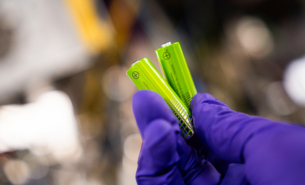formed termination species in an important class of two-dimensional materials known as MXene. The results have implications for the use of the material in energy storage and production applications.
MXenes are a novel class of two-dimensional materials offering properties that may be useful in many different applications such as composite materials with high strength, fuel- and solar cells, 2D-based electronics, and energy storage systems. These properties are to a large extent determined by how termination atoms are arranged on the surface of the two-dimensional sheet, which also makes MXenes highly customisable. An example is intercalating atoms between MXene sheets for energy storage applications such as anodes in supercapacitors and batteries. The fundamental knowledge of the electronic structure and bonding in these promising MXene-materials is until this point quite limited.
The researchers studied a type of MXene called Ti3C2Tx, where the sheet is built up of titanium, carbon, and inherent surface termination atoms, Tx. It is challenging to study the arrangement of surface atoms with spectroscopy as the signature that each atom and arrangement has is quite complex. The team used Ultraviolet and X-ray Photoelectron Spectroscopy and Resonant Photoemission Spectroscopy with a range of suitable photon energies tuned at the soft X-ray beamline SPECIES. This way they could conclude bonding and arrangement of the termination species Tx on the surface of Ti3C2. They could conclude that there were no hydroxide-groups (-OH) present on the surface, which has been believed to be the case. Instead, the termination species were identified to be fluorine (-F) and oxygen (-O) on the face-centered-cubic (fcc) sites and O also on the bridge site between two surface Ti atoms.
The next step is to expose Ti3C2Tx to H2, H2O and CO2 gas with the aim to modify the termination of the Ti3C2-surface. We will customise the MXene-material for better performance in applications such as energy storage and production, says Lars-Åke Näslund at Linköping University, one of the researchers behind the study.
Publication
Lars-Åke Näslund, Mikko-Heikki Mikkelä, Esko Kokkonen, and Martin Magnuson; Chemical bonding of termination species in 2D carbides investigated through valence band UPS/XPS of Ti3C2Tx MXene; 2D Mater. 8 (2021) 045026, DOI: 10.1088/2053-1583/ac1ea9




